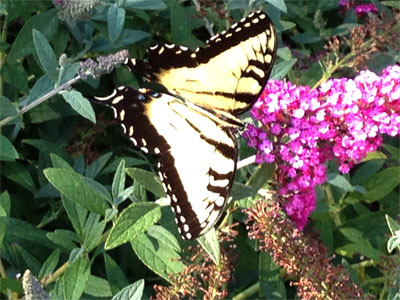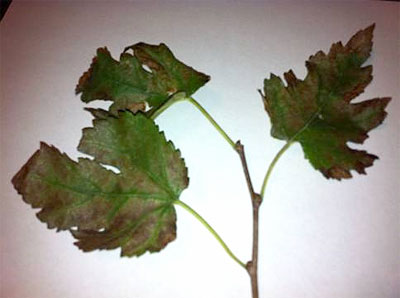Question and Answer — October 2013
If you’d like Neil’s help with your plant question, it’s as simple as sending that question and the photo to support it (required!) here. It really helps Neil be more precise if you’ll list your city in your e-mail. After all, what pertains to Amarillo doesn’t always fit in Beaumont! Neil chooses those questions that he feels will be of greatest interest to all of our readers. Plant ID questions, for example, seldom make the cut, since they are of concern only to the person sending them. But there’s a lot more to be seen here, so let’s check in with this month’s Q’s and Neil’s A’s.
Question: I planted a butterfly bush this spring, and it has thrived, now triple in size. How and when do I trim it back? I know I’m supposed to do so. C.K., no city given.

Answer: Sometime late this fall (November), trim it back to within 6 or 8 inches of the ground. It’s not really a shrub, and the severe cut-back will keep it compact and vigorous next year.
Question: Once my iris and cannas stop flowering and the heat makes them look like this, is it okay to cut them down, or do they need to be left intact to go completely dormant? J.G., Far North Dallas.


Answer: Good to see you here, my longtime friend. The iris in your photo could be trimmed to remove everything brown, even if that meant cutting some of the leaves back by one-third or one-half. However, the cannas need to be left in place until they’re killed to the ground by the first freeze. Green tissues in the foliage are producing much-needed sugars that will be stored in the plants’ roots over the winter.
Question: I would like to redo the landscape beneath this tree entirely. Right now there are iris there, but I understand they do better in full sun. I will transplant them. What type of greenery could I plant there year ‘round, and what would be a good source of annual color? K., Prosper.

Answer: “Yes” on getting the iris into the sun somewhere. In fact, I would enlarge the bed area somewhat and try to create a more natural serpentine form from it that also returns to the lawn at ground level (not elevated by the several inches). Then work up this bed carefully, mixing in several inches of organic matter. In the interest of time, I’ll just tell you what I would do here. There are a thousand options, and this is exactly the function of our annual Home Landscape School. Click for details. You might consider attending. If this were my yard, I would use regular mondograss through the entire area. In fact, I have mondograss covering spaces several times this size in our rural Collin County landscape. I have had absolutely no problems with it in 37 years. I would carefully place three or five round stepping stones in some kind of nice arrangement within the bed. I would buy that number of large decorative pots, and I would keep them filled with my annual flowers and foliage plants, changing as needed through the seasons. As a side note, your tree worries me just a bit. I can’t tell what type it is, but the arrangement of its trunks looks suspiciously like an ornamental pear. It looks weak, concerning me that it could split under the stress of wind or ice. You might want to talk to a certified nursery professional or a certified arborist about it.
Question: I have this invasive vine in my flowerbeds. Is there a way to eradicate it without harming my flowers? J.S., no city given.

Answer: This is one of several common types of wild morning glories. It twines tenaciously, so there is little way to get it out of floral plantings for the six or eight weeks we have left in that season. As you remove your warm-season color and make ready for pansies, rototill deeply and carefully, and remove all of its roots. Next year, when it comes time to plant during the summer, lay a roll-type mulch over the bed for one or two years and grow your color plants in decorative pots. It will be a nice and new look for your garden, and it will let you starve out the weed.
Question: I planted a 4-inch Shumard red oak two years ago. It suffered severe sun scald during its first summer. The canopy looked very healthy this year, but when I removed the paper tree wrap, the trunk looked deformed. Is this some type of canker rot? Should I plan a replacement sooner rather than later? T., Roanoke.

Answer: Coupled with your statement that the top growth looked good this summer, this roll of new, healing bark that is forming is a very positive sign. Sit tight. Your tree looks like it’s going to make a good recovery.
Question: I planted an apricot tree last fall. In the spring new shoots started growing from the bottom of the trunk. They look completely different from the rest of the tree. They are growing vigorously and are becoming the main growth of the tree. Should I cut them out? F.R., Allen.

Answer: They are sprouts from the rootstock of your apricot tree. That is to say that they are not the same variety that you planted originally. You must remove them at once. Sometimes this just seems to happen without reason, but more often, it’s because the grafted top growth of the tree isn’t healthy and vigorous. If it were, the process you learned about in high school biology (apical dominance) would have prevented their growing.
Question: What is this insect that has spread to cover cactus plants I transplanted from our pasture? How can I control it? S.S.W., between Caddo Mills and Greenville.

Answer: Here is the identification of this widespread scale of opuntias (prickly pears):
http://www.insectimages.org/browse/detail.cfm?imgnum=5121072.
Here is basic scale information from Colorado State University:
http://www.colostate.edu/Depts/CoopExt/4DMG/Pests/scale.htm.
Here’s some interesting information on the scale:
http://opuntiads.com/oblog/cochineal-scale-insect-dactylopius-coccus.
Hopefully those links will give you the information you needed.
Question: What are these white deposits on my plant? I’ve tried spraying with both an insecticide and a fungicide. Nothing has helped. Any advice? L.D., Plano.

Answer: As with the prior note, this is another scale insect. Use a systemic insecticide such as Imidacloprid as a soil drench. A horticultural oil spray would also help reduce the population, although the insects won’t necessarily fall off, even if you kill them.
Question: My liriope is all dying. It used to be very vigorous. I’m not sure if a disease is involved. Any suggestions, please? R.P., Farmers Branch.

Answer: There is at least some chance that this is drought-related. Only you will know if you’ve been really regular on keeping the plantings moist at all times. To the contrary, there is a well-documented fungal crown rot of liriope. Here is information from LSU to help you.
Question: What is causing this leaf problem on our Shumard red oak trees at the nursery? Is it likely to reappear next year? E.T., no city given.

Answer: This is vein pocket gall. I saw a ton of it in springs of 2011, 2012 and less in 2013. It’s not fatal, but it’s ugly. Here’s what our friend Dr. Mike Merchant with Texas A&M posted about it.
Question: Other than cutting or digging, is there a way to kill or spray sprouts that come up from the bases of our possumhaw hollies, wax myrtles, Texas mountain laurel and others? J.J., Parker County.


Answer: Those sprouts are tethered to the mother tree – they are parts of those trees, so “no” on spraying them. You would do damage to the mamas. I use a sharpshooter spade angled in at 30 degrees to sever shoots like this a few inches below ground while the soil is moist. You could temporarily remove the hardwood mulch, then cut and fit roll-type landscape fabric on top of the soil. That would discourage them. You could use your hardwood mulch to conceal the roll-type mulch. It’s not especially attractive without some type of covering.
Question: Most of my 40 roses are doing very fine, but this one is dying one stem at a time. I’ve read about Rose Rosette Virus, but the symptoms don’t seem to match here. What might you suggest? M.R., Fort Worth.

Answer: This doesn’t look like Rose Rosette Virus. (See story this issue.) The stump looks like this might be an old plant, so I wonder if it might just be running out of steam. Roses are also highly susceptible to cotton root rot, the soil-borne fungus. I lost one once with symptoms that looked somewhat like this. I don’t know of anything else to suggest. It would be easy enough to dig this entire plant and send it to the Texas Plant Clinic at Texas A&M for culture. That way you would know if your other plants are at risk. http://plantclinic.tamu.edu
Question: Just a couple of weeks ago our ornamental pear tree was green and beautiful. On a Monday it began to look “tired,” and by that Thursday, it was dead. The grass and all of our other plants still look fine. We haven’t sprayed anything. Any ideas? W., no city given.
Answer: I do have an idea. In fact, the cause is a soil-borne fungus called cotton root rot, and pears and apples are two of the most susceptible victims. It will be present in the soil for many years, then it suddenly will strike vulnerable plants. I’ve lost mallows (cotton relatives that they are), a forsythia, a couple of roses, Indian hawthorns and an oakleaf hydrangea to it over the years. I say all of this without even knowing where you live. That’s an important factor, since the disease is found only in alkaline soils. It is a prime reason why you no longer see cotton being grown in the I-35 corridor. Your best replacement tree of pretty much the same size and growth form would be Little Gem southern magnolia. It is not susceptible.
Question: This is my daughter’s tree. Its bark is splitting, and she is wondering if it is worth trying to save. We can’t determine what type of tree it is. C.U., Plano.


Answer: This is a seedling “volunteer” tree of a fruiting mulberry. A bird has probably digested a fruit and planted the seed for her. What you are seeing is their highly incised “juvenile” foliage. Normally, they’re acceptable trees (at best), but they’re messy. The fruit can stain concrete and other surfaces, and they draw flies. That’s to say nothing of the fact that there will be sprouts everywhere once it starts bearing fruit. The trunk damage is decay that probably resulted from a branch that died and wasn’t pruned away properly. I can only give you my own opinion, and that is that I would not try to save this tree. I’d have it out of the way by the end of this weekend. My answer would probably be the same even for a healthy mulberry.


